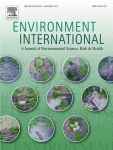Environment International 49
Overview of articles on POPs in a new issue of the Environment International journal.

Pages 1-8
Alin C. Dirtu, Nadeem Ali, Nele Van den Eede, Hugo Neels, Adrian Covaci
- Human exposure to multiple classes of chemicals via dust ingestion was assessed.
- Exposure via dust in Romania decreases as OCPs>OPFRs≫PBDEs≈PCBs>NBFRs.
- Intake of OCPs via dust ingestion was higher than the reference dose.
- OCPs should be included in indoor investigations.
Pages 57-82
Åke Bergman, Andreas Rydén, Robin J. Law, Jacob de Boer, Adrian Covaci, Mehran Alaee, Linda Birnbaum, Myrto Petreas, Martin Rose, Shinichi Sakai, Nele Van den Eede, Ike van der Veen
- A standard is proposed for abbreviations of brominated, chlorinated and phosphorus containing flame retardants (BFRs, CFRs and PFRs).
- The standard is aimed to simplify and promote scientific communication related to BFRs, CFRs and PFRs.
- Structured abbreviations (STABs) are prepared in close relation to the chemical structure of the BFRs, CFRs and PFRs.
- Practical abbreviations (PRABs) are in general derived from the STABs or from commonly used abbreviations from the past.
- Established, emerging, novel and potential BFRs, CFRs and PFRs are defined.
Pages 83-91
Cristina L. Quinn, James M. Armitage, Knut Breivik, Frank Wania
- We present a method for quantifying effects of dietary transitions on POPs exposure.
- Reduced emissions (1980 to 2020) decreases PCB-153 body burden by 6–13 fold.
- Dietary transitions account for an additional factor of 2–50 fold decrease.
- Dietary transitions contribute to the variability within and between populations.
- Dietary transition details are required to interpret human biomonitoring data in the Arctic.
Pages 92-99
Jenny Bytingsvik, Stefan P.J. van Leeuwen, Timo Hamers, Kees Swart, Jon Aars, Elisabeth Lie, Else Mari Espseth Nilsen, Øystein Wiig, Andrew E. Derocher, Bjørn M. Jenssen
- Plasma levels of 7 PFCAs and 2 PFSAs in polar bear mother–cub pairs from Svalbard.
- Mother–cub transfer and between-year differences (1998 vs. 2008) were investigated.
- PFCA and PFSA levels in suckling cubs were significantly lower than in their mothers.
- Mothers and cubs: most PFCAs were higher and PFOS were lower in 2008 compared to 1998.
- PFAS levels were above levels associated with health effects in humans.
Dietary exposure to perfluoroalkyl acids for the Swedish population in 1999, 2005 and 2010
Pages 120-127
Robin Vestergren, Urs Berger, Anders Glynn, Ian T. Cousins
- Dietary exposure to perfluoroalkyl acids (PFAAs) for the Swedish population was quantified.
- The contribution of different food groups to the total dietary exposure differed with the chain-length of PFAAs.
- Dietary intake was the major ongoing exposure pathway for and long-chain PFAAs.
- Drinking water intake was identified as an important exposure pathway for short-chain PFAAs.
- Average dietary intakes of PFAAs displayed a small inter-year variation over the period 1999 to 2010
25.10.2012




